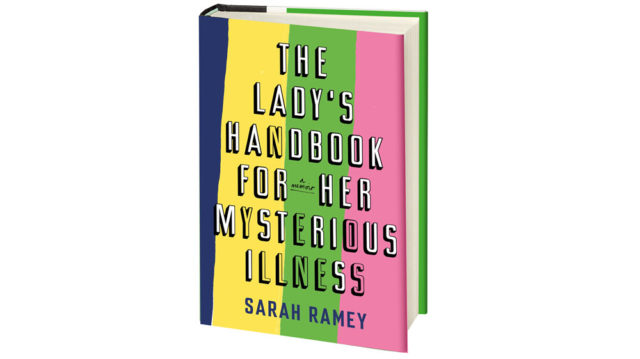Often, when I find myself in possession of a really good book, I’ll devour the first three-quarters of it immediately. Then, realizing the ride is about to be over and I don’t want to get off, I’ll put the book aside and pick up something else. I start rationing my reading. I limit myself to a few pages at a time.
Such was the case with The Lady’s Handbook for Her Mysterious Illness by Sarah Ramey. Part illness memoir, part self-help book, and part manifesto, it was an odd blend of genres with a narrative arc that didn’t quite match anything I’ve ever read. Ramey bounded through it all with an exuberance that defies her myalgic encephalomyelitis/chronic fatigue syndrome (one of Ramey’s many diagnoses).
It was because of this enthusiasm that I found myself charmed and sympathetic, even through the book’s many digressions and tenuous claims.
The Mystery Woman
Ramey spent years of her life, and outrageous sums of money, accumulating the experiences that allowed her to write this book. It was not a price she set out to pay, but no one gets to choose their illnesses.
In 2003, when Ramey was twenty-one, her doctor suggested urological surgery to address an oddly persistent urinary tract infection. To put it mildly, the surgery did not go well, and Ramey spent the next seventeen years dealing with constant pain and a collection of chronic illnesses.
Even more vexing, every doctor she visited declared that she was the picture of health. All her gynecological, urological, and gastroenterological tests came back perfectly normal. Her only problem was an acute case of, in Ramey’s words, “Irritable Woman Syndrome.”
It would be years before Ramey was awarded her first solid diagnosis. She was infested with a roundworm in the Strongyloides genus, which she had probably picked up during a visit to Costa Rica as a teenager.
This tidbit may be a spoiler, but I promise it’s not a significant one, given Ramey’s subsequent, tortuous path through medicine.
Although she took her medications dutifully, which should have cleared up this infestation, Ramey felt just as horrible as ever. Over the years, she would periodically be handed new diagnoses, many of which were poorly understood and untreatable.
Ramey cycled through phases of being semi-functional, and being completely incapacitated. There were long periods when she lived in a nest of blankets, curled up at the base of the toilet. She didn’t have the strength to walk to the bathroom for her twenty-plus daily bowel moments (which were, naturally, excruciatingly painful).
At other times, she required a wheelchair, and round-the-clock nursing. Even blinking was unbearably exhausting.
Ramey’s good periods involved relatively modest achievements, like being able to get her own groceries, or meet a friend for coffee once a week.
When she was well enough to do so, Ramey spent her days desperately searching for a cure, or at least a treatment. Her run-ins with the medical establishment ranged from disappointing to traumatic. It was years before she found a doctor who could admit that her issues might have a physical basis. She was regularly referred to psychiatrists, and encouraged to try antidepressants. Some of her encounters were so horrific that they made her illnesses sound soothing.
During her nonfunctional phases, Ramey’s family members took over, and continued to drag her from doctor to doctor. Their efforts yielded nothing but bills. Although both of Ramey’s parents, and several members of her extended family were doctors, they were as mystified as anyone else.

Introducing the WOMIs
During her illness, or at least during the more functional phases of it, Ramey discovered that she was not the special unicorn patient that she had assumed. Her case was mysterious, yes, but she was not alone. Thousands – millions, even – of women suffered a staggering and bizarre array of symptoms which seemed related, but didn’t add up to any particular disease.
Ramey dubbed these women WOMIs, short for Woman with a Mysterious Illness.
My first question, which might also be yours, was: Why women, specifically? Was Ramey purposely overlooking all the mystery men, perhaps for ideological reasons?
But no, Ramey makes a solid case that women are predominantly, although not exclusively, affected by these mystery diseases. The neurological, autoimmune, and chronic pain syndromes that make up the foundational diagnoses for WOMIs are all more common in women, and by shockingly large margins.
Of course, even if you accept that the overwhelming majority (75–90%) of patients with mystery illnesses are women, their ranks are vast enough to include thousands, even millions, of men.
Ramey recognizes these patients (which she dubs MOMIs, or Men with Mysterious Illnesses), and acknowledges they may also be dismissed by traditional doctors. However, men are peripheral to her story, and for the most part, Ramey speaks directly to women.
Ramey spends a considerable part of the book outlining what it means to be a WOMI: What sort of symptoms make up this pattern of illness, what biological and neurological differences might account for their symptoms, and what functional levels a WOMI can exist at.
Admittedly, Ramey tends to overgeneralize, speculate, assume, and push ahead of the science. The borders of her WOMI-dom are shifting and permeable. Her suggested treatments range from the pragmatic to the fringe.
But I was willing to overlook these flaws and more, because I saw that Ramey was really driving at a larger point. She’s staring at a chaotic mess of symptoms, illnesses, etiologies, and treatments, and trying to assemble them into a larger structure.
She was bound to be wrong on some of the particulars, but her larger points stick together, if not always neatly. The value of the book is that it gives readers a comprehensive perspective on the WOMI architecture.
What Privilege Gets You
At the beginning of the story, Ramey is that rare, enviable sort of woman who seems to have everything going for her. She is young, attractive, talented, white, well-educated, and comes from a wealthy family. Both her parents are doctors. Her stepfather was a doctor. Her grandmother was a doctor.
And still, throughout the book, we see Ramey fall deeper and deeper into the black pit of illness and medicine. She spends unfathomable amounts of money. She searches for cures around the country. She tries every conceivable mode of alternative therapy.
At one point, Ramey travels hours to visit a urologic surgeon who treats her with open disdain. The un-anesthetized torture he performs on her labia is the stuff of horror movies.
Despite her advantages, despite her uncontrollable screaming and crying, despite the fact that her mother – a doctor – was in the room, Ramey has absolutely no recourse against this doctor. She can lodge a complaint with the hospital, which will certainly be ignored.
Even if she could somehow summon the time, energy, and money to sue (a big if, given her fragile health), it’s unlikely that legal action would accomplish anything. The doctor’s actions were performed behind closed doors. His version of events is the official one. Ramey’s word – that of a chronically ill woman with a trail of psychiatric referrals behind her – would not be worth much.
When I read this section, I reflected: So, this is the top-tier medical system that, theoretically, only the rich and privileged have access to?! If so, God help us all. It’s a house of horrors, from top to bottom.
At many points throughout the book, I found myself thinking that Ramey might have fared better with fewer advantages. Poverty and a lack of education might have limited her exposure to both the health care system, and wellness culture. Many of the expensive interventions she tried seemed to do her more harm than good.

An Unreasonable Alternative
Ramey’s experiences with traditional medicine were horrible, but I’ve come to expect that. It was Ramey’s observations on alternative medicine that I found enlightening.
Aside from a few short-lived experiments with turmeric tea and valerian root, I never waded much into the waters of alternative medicine. Ramey, on the other hand, plunged in like she was diving for pearls.
She tried water fasts, all-raw-milk diets, aromatherapy, osteopathy, feng shui, ice baths, self-hypnosis, and a number of positive-thinking modalities. She moved across the country to start seeing a superstar acupuncturist. She moved again to take illegal ozone therapy treatments. Her yoga studio became her second home.
Unlike her doctors, the alternative therapy practitioners treated Ramey like a real person. They listened to her. They were empathetic. They believed in her potential. This was a welcome contrast to cold, depersonalizing atmosphere of hospitals and clinics.
But the flaws in these modalities revealed themselves slowly. Ramey would throw herself whole-heartedly into some bizarre program, and then, after she’d spent much time, energy, and money on it, she would have to acknowledge that she was not getting better.
According to her various gurus, there was only one possible explanation: She wasn’t trying hard enough. Recovery was the only true test of commitment. If it didn’t happen, the fault must be in her. After a certain number of repetitions, Ramey grew skeptical.
The relentless focus on positive thinking in the wellness community seemed less and less like freedom, and more and more like a straightjacket. Why were all negative emotions treated as uniformly and inherently verboten?
Weren’t there times, such as during her visit with the spiteful urologic surgeon, when anger, fear, and even hatred were not only warranted, but healthy? Didn’t negative emotions exist to serve some useful purpose?
Although Ramey still embraces some tenets of alternative medicine, she grew disillusioned with the narrow expectations and short-sighted dogmatism of many practitioners. To heal, Ramey needed to strike out on her own.
A WOMIs Search for Meaning
During her worst phases, Ramey’s life contained little that was worth getting excited about. She couldn’t work. She couldn’t leave the house. She couldn’t even read. And the chances of finding a cure grew ever more remote.
Somewhere in this morass of despair, Ramey realized that a person needs more than food and oxygen to get through their days. They need a sense of purpose. And what useful purpose can your life serve when you’re chained to the toilet and too weak to make coffee?
Her need for a purpose became as keen as the need for a cure. Thankfully, this was an easier quest, since there are any number of life callings that will serve. Ramey came to hers through an obscure work of feminist literary criticism: The Heroine’s Journey: Woman’s Quest for Wholeness by Maureen Murdock.
A long chunk in the middle of Ramey’s book is devoted to explaining the book’s teachings, and her own, newly expanded, point of view. While Ramey does cover some interesting intellectual territory, this section does tend to drag, and the advice she offers later, based partly on her revelations, is often questionable.
But there was something urgent about Ramey’s tour through literary theory, and I couldn’t wholly write it off as long-winded or self-indulgent.
I will summarize this section as: Ramey was in a dark place, and she found this light. Now she’s sharing it, in the hopes that someone else can light a candle from her lamp.
I can see why Ramey found this section deserving of such weight, even if I skimmed over portions of it. I have my own sense of purpose, and don’t need to borrow someone else’s.
But Ramey has been to dark valleys that I haven’t visited, and if she tries too hard to pass on every scrap of information that helped lead her through, well, I can’t judge her too harshly for that. Who knows? Perhaps her musings will help someone who isn’t me.
A Healthy Debate
Other reviewers have been more critical of Ramey’s work than I am. Perhaps you will be one of them. The Lady’s Handbook for Her Mysterious Illness contains plenty to discuss, debate, and argue over.
And those discussions, debates, and arguments will no doubt be healthy. It’s = easy for certain types of illnesses to go unnoticed and unremarked on, though they may be detrimental to sufferers. Acknowledging and discussing these conditions is a step forward.
Maybe you have your own opinions about the role of beans or grains in a healthy diet, or you think concerns about processed food about overblown. Perhaps you have your suspicions about the value of “functional medicine.” Perhaps any assertions about the importance meditation or gratitude for health make you want to punch the speaker in the face.
Perhaps you think that other failings of the medical system deserve higher priority. Perhaps you fear that men or non-heterosexual people are being overlooked. Perhaps you wonder whether demands for systemic change really must spring from an idiosyncratic form of feminism.
Despite its prescriptive stances, The Lady’s Handbook for Her Mysterious Illness invites just such opinions from readers. It’s the first word, not the final word. Go ahead: Speak your piece.
